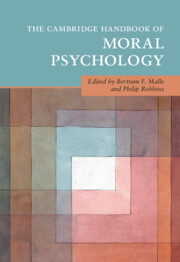Book contents
- The Cambridge Handbook of Moral Psychology
- Cambridge Handbooks in Psychology
- The Cambridge Handbook of Moral Psychology
- Copyright page
- Contents
- Figures
- Tables
- Contributors
- Preface
- 1 Modern Moral Psychology
- Part I Building Blocks
- Part II Thinking and Feeling
- Part III Behavior
- 12 Prosociality
- 13 Antisocial and Moral Behavior
- 14 Intergroup Conflict and Dehumanization
- 15 Blame and Punishment
- 16 Moral Communication
- Part IV Origins, Development, and Variation
- Part V Applications and Extensions
- Index
- References
16 - Moral Communication
from Part III - Behavior
Published online by Cambridge University Press: 20 February 2025
- The Cambridge Handbook of Moral Psychology
- Cambridge Handbooks in Psychology
- The Cambridge Handbook of Moral Psychology
- Copyright page
- Contents
- Figures
- Tables
- Contributors
- Preface
- 1 Modern Moral Psychology
- Part I Building Blocks
- Part II Thinking and Feeling
- Part III Behavior
- 12 Prosociality
- 13 Antisocial and Moral Behavior
- 14 Intergroup Conflict and Dehumanization
- 15 Blame and Punishment
- 16 Moral Communication
- Part IV Origins, Development, and Variation
- Part V Applications and Extensions
- Index
- References
Summary
This chapter of the handbook consists of a two-part discussion of moral communication, highlighting the topic of punishment. In the first part, the authors focus on what makes human forms of communication distinctive, whether linguistic or nonlinguistic, and on what distinguishes moralized norms from normative attitudes and behaviors. They argue that the transgression of moralized norms is distinctive in that it tends to provoke a strong desire to punish transgressors, where such punishment has a communicative dimension. In the second part, the authors review psychological research on why people punish and discuss its communicative aspects. They propose that a communicative framework not only resolves major ongoing debates between traditional camps (retributive vs. consequentialist) but also potentially accounts for some otherwise puzzling findings. Studying the symbolic meaning of punishment along with its intended recipients opens up promising new avenues for research into factors that could modulate people‘s taste for punishment.
Keywords
- Type
- Chapter
- Information
- The Cambridge Handbook of Moral Psychology , pp. 382 - 406Publisher: Cambridge University PressPrint publication year: 2025

